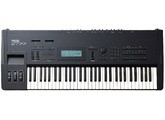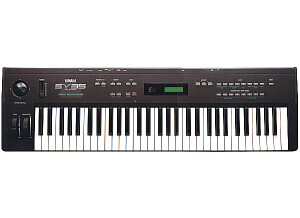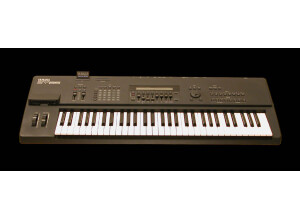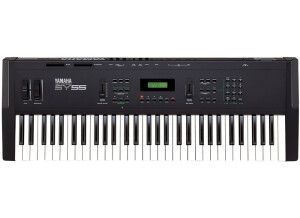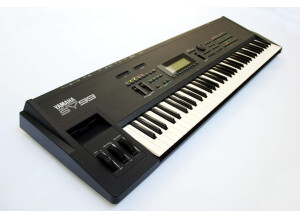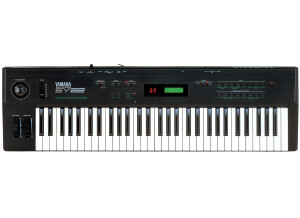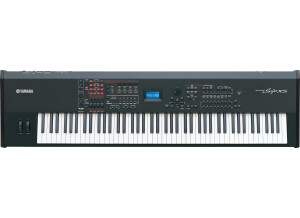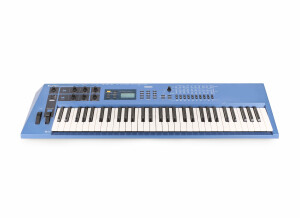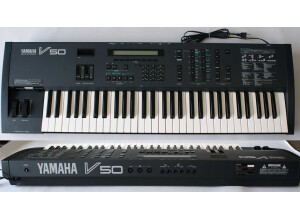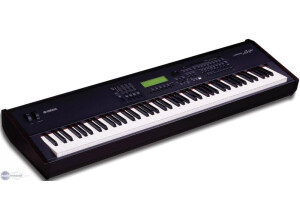Tech. sheet
- Manufacturer: Yamaha
- Model: SY77
- Series: SY
- Category: Digital Synths
- Year of release : 1989
- Synthesis type : AWM + FM Synthesis
- Maximum polyphony : 32 voices
- Multitimbrality : 16 parts
- Number of keys : 61 keys
- Keybed type : Semi-weighted
- Built-in sampler : No
- Built-in sequencer : Yes
- Built-in arpeggiator : Yes
- Number of user presets : 64 performances
- MIDI I/O : In, Out, Thru
- Audio outputs : Stereo Output
- Power supply : AC Adapter
- Dimensions : 1050 x 390 x 105 mm
- Weight : 14 kg
- Other names:sy77, sy 77
»
Videos
User reviews
4.7/5(14 reviews)
5
64 %
4
14 %
3
7 %
2
1
Published on 02/12/10 at 03:33 (This content has been automatically translated from French)
your music is good is that your SY77 ensures pas.ca not sound bad either you or it's mix of many lonely sounds happening on the size above with big sound or purchases processors to inflate .c ' is ugly to listen to your music, ca not highlight the SY77 ca listening rather claps in size and are even no processor cul.je not even talk to you a 3 emulator or an analog synth http: / /www.youtube.com/watch?v=nesrCPjLLNc&feature=related
00
»
In line with expectations, so wonderful
Published on 11/10/13 at 07:07 (This content has been automatically translated from French)Keyboard 61 keys with aftertouch, all possible conventional connections. Wheels 2 and modulation. But not balanced audio outputs.
Digital frequency synthesis "advanced" modulation (AFM) from the words of the days of Yamaha and a sampler (AWM). The basic philosophy of this key is to combine the performance of the FM to the sampler, one overcomes the shortcomings of the other, to get to make possible at the time the most realistic sounds, but totally overwhelmed today.
Unlike its big brother SY99 (it overpriced), the SY77 does not use its own samples. Only store-bought cards could propose to increase the collection of samples. It is not impossible that on the other hand in the near...…
Digital frequency synthesis "advanced" modulation (AFM) from the words of the days of Yamaha and a sampler (AWM). The basic philosophy of this key is to combine the performance of the FM to the sampler, one overcomes the shortcomings of the other, to get to make possible at the time the most realistic sounds, but totally overwhelmed today.
Unlike its big brother SY99 (it overpriced), the SY77 does not use its own samples. Only store-bought cards could propose to increase the collection of samples. It is not impossible that on the other hand in the near...…
Read more
Keyboard 61 keys with aftertouch, all possible conventional connections. Wheels 2 and modulation. But not balanced audio outputs.
Digital frequency synthesis "advanced" modulation (AFM) from the words of the days of Yamaha and a sampler (AWM). The basic philosophy of this key is to combine the performance of the FM to the sampler, one overcomes the shortcomings of the other, to get to make possible at the time the most realistic sounds, but totally overwhelmed today.
Unlike its big brother SY99 (it overpriced), the SY77 does not use its own samples. Only store-bought cards could propose to increase the collection of samples. It is not impossible that on the other hand in the near future, passionate develop a map that allows to do so.
Each setting can be monophonic or not, in fact I do not know how many votes beings can play at the same time (around 16) since it can play a setting that uses either the FM or samples, or both that pass through the independent processors each other.
Effects reverb, chorus, flanger, distortion, echo are available, but I will not go into details about their configuration because I'm no expert in this field, ie there where it takes far to enhance the sound. But if you just to bypass instead of completely disable, one can perceive a change in its origin not so desirable ...
This keyboard has a pretty basic but sufficient sequencer to develop small prototypes. It is limited to the maximum number of playable voices simultaneously. Some sounds can be played later than expected or even outright cut to play another. To make a piece without these bugs requires patience computer programmer 70 years to optimize it. Blah blah ...
It is possible to "retune" the keys to play pentatonic songs or even more exotic, which gave him success among others in the Maghreb countries.
UTILIZATION
What worried me most was the constraint of small LCD screen making it difficult to setup. This method, however, was what was best at the time, could not escape. In addition, the interface is not intuitive at all and it is necessary to train with the manual, which fortunately, is sufficiently well done to him by going to essentially no more.
However, once used you can finally notice the ingenious designers work despite these technical constraints, and use becomes very fluid.
Managing files and other settings is catastrophic. I recommend using a "librarian" to be able to separate and save the settings, and the transfer will flexibly to the keyboard via SysEx.
SOUNDS
Sounds very 1990 and the pre settings can be easily recognized in a few productions of the time, giving a kitsch mind the keyboard. As stated above, the samples were very good at the time but are really usable as is. You can make very convincing and worked better than the default settings.
However nowadays this keyboard is one of the most functional in FM synthesis, which particularly interested me. It is now possible to innovate with this keyboard producing using the knowledge and tools now available, sounds that have very little to do with the typical horror video games arcade years 80, and also because the FM synthesis has left plenty of room in the market compared to the much more common subtractive synthesis.
OVERALL OPINION
I use it for 6 months, and I hesitate to use it as a MIDI master keyboard so that the touch is nice. I would have liked a DX7, but the sequencer that I decided to buy the SY77 to work independently of a prototype PC.
When you know that the SY77 was the most high-end Yamaha in 1990, we can expect some very good stuff that is the same case today.
One can find specimens variable bargain price. What really makes the difference is the wearing of buttons that can be less damped or buttons whose contacts may strain. You can always try to negotiate the price of the floppy drive belt which relaxes to the point of not turning anything (ultra easily replaceable), or the LCD screen has no backlight .
Note that the disk drive can be replaced completely by a block of flash memory, and the LCD screen can be replaced by models of completely different colors and which less greedy backlighting eliminates the need of the inverter that sizzles and make the perfectly silent keyboard.
In the end, even the synthesis of this keyboard is 100% digital, and thus replaceable by software on a computer, it will keep this collector's spirit and independence that is precious to me.
Digital frequency synthesis "advanced" modulation (AFM) from the words of the days of Yamaha and a sampler (AWM). The basic philosophy of this key is to combine the performance of the FM to the sampler, one overcomes the shortcomings of the other, to get to make possible at the time the most realistic sounds, but totally overwhelmed today.
Unlike its big brother SY99 (it overpriced), the SY77 does not use its own samples. Only store-bought cards could propose to increase the collection of samples. It is not impossible that on the other hand in the near future, passionate develop a map that allows to do so.
Each setting can be monophonic or not, in fact I do not know how many votes beings can play at the same time (around 16) since it can play a setting that uses either the FM or samples, or both that pass through the independent processors each other.
Effects reverb, chorus, flanger, distortion, echo are available, but I will not go into details about their configuration because I'm no expert in this field, ie there where it takes far to enhance the sound. But if you just to bypass instead of completely disable, one can perceive a change in its origin not so desirable ...
This keyboard has a pretty basic but sufficient sequencer to develop small prototypes. It is limited to the maximum number of playable voices simultaneously. Some sounds can be played later than expected or even outright cut to play another. To make a piece without these bugs requires patience computer programmer 70 years to optimize it. Blah blah ...
It is possible to "retune" the keys to play pentatonic songs or even more exotic, which gave him success among others in the Maghreb countries.
UTILIZATION
What worried me most was the constraint of small LCD screen making it difficult to setup. This method, however, was what was best at the time, could not escape. In addition, the interface is not intuitive at all and it is necessary to train with the manual, which fortunately, is sufficiently well done to him by going to essentially no more.
However, once used you can finally notice the ingenious designers work despite these technical constraints, and use becomes very fluid.
Managing files and other settings is catastrophic. I recommend using a "librarian" to be able to separate and save the settings, and the transfer will flexibly to the keyboard via SysEx.
SOUNDS
Sounds very 1990 and the pre settings can be easily recognized in a few productions of the time, giving a kitsch mind the keyboard. As stated above, the samples were very good at the time but are really usable as is. You can make very convincing and worked better than the default settings.
However nowadays this keyboard is one of the most functional in FM synthesis, which particularly interested me. It is now possible to innovate with this keyboard producing using the knowledge and tools now available, sounds that have very little to do with the typical horror video games arcade years 80, and also because the FM synthesis has left plenty of room in the market compared to the much more common subtractive synthesis.
OVERALL OPINION
I use it for 6 months, and I hesitate to use it as a MIDI master keyboard so that the touch is nice. I would have liked a DX7, but the sequencer that I decided to buy the SY77 to work independently of a prototype PC.
When you know that the SY77 was the most high-end Yamaha in 1990, we can expect some very good stuff that is the same case today.
One can find specimens variable bargain price. What really makes the difference is the wearing of buttons that can be less damped or buttons whose contacts may strain. You can always try to negotiate the price of the floppy drive belt which relaxes to the point of not turning anything (ultra easily replaceable), or the LCD screen has no backlight .
Note that the disk drive can be replaced completely by a block of flash memory, and the LCD screen can be replaced by models of completely different colors and which less greedy backlighting eliminates the need of the inverter that sizzles and make the perfectly silent keyboard.
In the end, even the synthesis of this keyboard is 100% digital, and thus replaceable by software on a computer, it will keep this collector's spirit and independence that is precious to me.
See less
274
»
The Black Queen
Published on 10/30/13 at 04:05 (This content has been automatically translated from French)Everyone know. A hybrid FM / AWM, but more importantly, an enlarged DX!
SY Manager urged (for twenty euros, a great humanist its author!).
If you want a taste of good use of this monster:
https://www.electric-himalaya.com/yamaha_sy77_sy99.html
Personally, I bought this bank, and I do not regret it ...
If you're like me, a fan of Roger Waters, you can hear in the SY album Amused to Death.
UTILIZATION
The large screen is welcome, because there are a lot of pages and settings. Editing is more than a serious business, not to say difficult ... As with the DX, it takes a little know where you're going, or you may change values without any audible result. Indeed, many...…
SY Manager urged (for twenty euros, a great humanist its author!).
If you want a taste of good use of this monster:
https://www.electric-himalaya.com/yamaha_sy77_sy99.html
Personally, I bought this bank, and I do not regret it ...
If you're like me, a fan of Roger Waters, you can hear in the SY album Amused to Death.
UTILIZATION
The large screen is welcome, because there are a lot of pages and settings. Editing is more than a serious business, not to say difficult ... As with the DX, it takes a little know where you're going, or you may change values without any audible result. Indeed, many...…
Read more
Everyone know. A hybrid FM / AWM, but more importantly, an enlarged DX!
SY Manager urged (for twenty euros, a great humanist its author!).
If you want a taste of good use of this monster:
https://www.electric-himalaya.com/yamaha_sy77_sy99.html
Personally, I bought this bank, and I do not regret it ...
If you're like me, a fan of Roger Waters, you can hear in the SY album Amused to Death.
UTILIZATION
The large screen is welcome, because there are a lot of pages and settings. Editing is more than a serious business, not to say difficult ... As with the DX, it takes a little know where you're going, or you may change values without any audible result. Indeed, many parameters are interrelated and influence each other (like the DX found the spirit of Dave in the Chowning FM programming). Be especially attentive to envelopes, it is especially here that the changes will be decisive. Modulations are numerous and better note than we selected when changing page, because if you forget to turn it on, it will need to increase their rates in another page ...
SOUNDS
Here is finally a synth that reminds us that this is a synth! Needless to seek a contemporary use of AWM samples: the "workstations" Today do that very well. When you look at the screen, it reads: "Music Synthesizer". That said it all: it is the spirit that reigns DX: sounds and emulations MUSICAL, expressive with shades, it was the spirit chosen by Yamaha in the 80/90. No wonder Chick Corea has always followed. With SY, it is expressed, it is inspired, it breathes ...
Most often, a 2AFM configuration is ample to create complex sounds or rich. The SY excels in environments and evolving textures. It reminds a bit of Korg Wavestation, since looping envelopes to 5 segments themselves are made of the sequence of waves. Certainly more subtle! RCM (Real time Convolution Modulation) is a major advantage: you Inject in FM algorithms signal a sample AWM (for short). It usually results in a slight distortion of the signal and a harmonic addition missing out. For example, an FM signal modulated by a little copper a sample voice nickname give particular granularity, giving the impression to hear the air pass through the throat in addition to the vibration of the vocal cords, with an effect "hoarseness "... We can even exclude the direct wave signal AWM output for even greater effect. Nobody can imitate or reproduce such a sound. The SY is an authentic synth apart, without the disadvantages of digital: each note down, there will never twice the same sound ... He's alive.
The resonant filters do their job with a sound a little chilly, yes, but effective, especially in conjunction with the LFO, in the sounds. They are a boon when it connects to one of three modulation wheel or aftertouch.
Regarding the effects, modulations flange / chorus / symphonic are set parallel with the SPX brand. They are frank and sharp, a little cold. Reverbs are of the same ilk. Finally, the delays are as usual with Yamaha deadly and accurate.
OVERALL OPINION
This is once again a long history, with breaks and renouements ... Do not dispose of the instrument when you get tired a little bit. It is better to question oneself and personal problems rather than abandon such a synth. Anyway, this is a very strong instrument! It passes through many years and revise easily and inexpensively. Therefore, we can meet and find it quite easily. We all do mistakes, you can not keep everything ... but him! If! We must keep it.
On stage, he crossed out the mix, it adds a medium / medium high appreciable coloration. It thus complements happily a varied set of multiple colors, what should always be to have a wide range, such as painting.
SY Manager urged (for twenty euros, a great humanist its author!).
If you want a taste of good use of this monster:
https://www.electric-himalaya.com/yamaha_sy77_sy99.html
Personally, I bought this bank, and I do not regret it ...
If you're like me, a fan of Roger Waters, you can hear in the SY album Amused to Death.
UTILIZATION
The large screen is welcome, because there are a lot of pages and settings. Editing is more than a serious business, not to say difficult ... As with the DX, it takes a little know where you're going, or you may change values without any audible result. Indeed, many parameters are interrelated and influence each other (like the DX found the spirit of Dave in the Chowning FM programming). Be especially attentive to envelopes, it is especially here that the changes will be decisive. Modulations are numerous and better note than we selected when changing page, because if you forget to turn it on, it will need to increase their rates in another page ...
SOUNDS
Here is finally a synth that reminds us that this is a synth! Needless to seek a contemporary use of AWM samples: the "workstations" Today do that very well. When you look at the screen, it reads: "Music Synthesizer". That said it all: it is the spirit that reigns DX: sounds and emulations MUSICAL, expressive with shades, it was the spirit chosen by Yamaha in the 80/90. No wonder Chick Corea has always followed. With SY, it is expressed, it is inspired, it breathes ...
Most often, a 2AFM configuration is ample to create complex sounds or rich. The SY excels in environments and evolving textures. It reminds a bit of Korg Wavestation, since looping envelopes to 5 segments themselves are made of the sequence of waves. Certainly more subtle! RCM (Real time Convolution Modulation) is a major advantage: you Inject in FM algorithms signal a sample AWM (for short). It usually results in a slight distortion of the signal and a harmonic addition missing out. For example, an FM signal modulated by a little copper a sample voice nickname give particular granularity, giving the impression to hear the air pass through the throat in addition to the vibration of the vocal cords, with an effect "hoarseness "... We can even exclude the direct wave signal AWM output for even greater effect. Nobody can imitate or reproduce such a sound. The SY is an authentic synth apart, without the disadvantages of digital: each note down, there will never twice the same sound ... He's alive.
The resonant filters do their job with a sound a little chilly, yes, but effective, especially in conjunction with the LFO, in the sounds. They are a boon when it connects to one of three modulation wheel or aftertouch.
Regarding the effects, modulations flange / chorus / symphonic are set parallel with the SPX brand. They are frank and sharp, a little cold. Reverbs are of the same ilk. Finally, the delays are as usual with Yamaha deadly and accurate.
OVERALL OPINION
This is once again a long history, with breaks and renouements ... Do not dispose of the instrument when you get tired a little bit. It is better to question oneself and personal problems rather than abandon such a synth. Anyway, this is a very strong instrument! It passes through many years and revise easily and inexpensively. Therefore, we can meet and find it quite easily. We all do mistakes, you can not keep everything ... but him! If! We must keep it.
On stage, he crossed out the mix, it adds a medium / medium high appreciable coloration. It thus complements happily a varied set of multiple colors, what should always be to have a wide range, such as painting.
See less
440
»
Published on 01/04/13 at 14:06 (This content has been automatically translated from French)
Workstation with FM and AWM sample playback. FM operators 6 to 16 waveforms, 45 algorithm, three feedback loops configurable injection or white noise waveform in AWM operators with adjustable level.
AWM 48KHz with sixty waveforms (included percussion)
2 multi-effects (chorus / flanger + reverb / delay / distortion) is used simulanément 4 effects on the voice.
A voice is composed of 1 or 2 element FM and AWM element 1 or 2 (mono possible). Each element passes through two filters in series 12dB/oct LPF and which one is the other LPF or HPF configurable. The resonance is common to both.
You can assign the cutoff velocity but not the amplitude of the filter envelope, which is...…
AWM 48KHz with sixty waveforms (included percussion)
2 multi-effects (chorus / flanger + reverb / delay / distortion) is used simulanément 4 effects on the voice.
A voice is composed of 1 or 2 element FM and AWM element 1 or 2 (mono possible). Each element passes through two filters in series 12dB/oct LPF and which one is the other LPF or HPF configurable. The resonance is common to both.
You can assign the cutoff velocity but not the amplitude of the filter envelope, which is...…
Read more
Workstation with FM and AWM sample playback. FM operators 6 to 16 waveforms, 45 algorithm, three feedback loops configurable injection or white noise waveform in AWM operators with adjustable level.
AWM 48KHz with sixty waveforms (included percussion)
2 multi-effects (chorus / flanger + reverb / delay / distortion) is used simulanément 4 effects on the voice.
A voice is composed of 1 or 2 element FM and AWM element 1 or 2 (mono possible). Each element passes through two filters in series 12dB/oct LPF and which one is the other LPF or HPF configurable. The resonance is common to both.
You can assign the cutoff velocity but not the amplitude of the filter envelope, which is unfortunate.
2 LFOs per voice which one can modulate the pitch.
Otherwise envelope generators have four break points and can loop over the segment you want (cool!)
Each element has its voice settings range, velocity, etc.., Pitch envelope and (original) pan!
Multi 16 votes.
Sequencer 10,000 events, 1 piece, 16 tracks including one for patterns (100), KSEQ proprietary format (not recording and will not play MIDI files)
2 sets of stereo outputs, if connectivity standard. Two modulation wheels.
Sturdy construction and nice keyboard compared to current stews.
UTILIZATION
The manual is adequate without being exhaustive. The screen is not too many parameters to display. Navigation requires the use of the ENTER key not very conveniently located on the numeric keypad. Can enter values for alpha-dial potentiometer, + / - buttons or digitally.
Screen but 2 or 3 tenths of a second to change is rapid but not immediate. Its brightness is adjustable but in general there's nothing too.
I find it convenient to use enough given the number of parameters. The screen can display curves, keyboard or things like that that help visualier what we do.
The copy function is very convenient (adpate is the context from which it was called).
I regret qu'li there are only 64 user memories voice.
Also, given the power of this machine, it does not sound in 5 minutes, it requires to spend time, you better enjoy it!
SOUNDS
Thanks to the improvement introduced by Yamaha FM SY-77 can produce sounds much more varied than the DX-7, and the combination with the AWM really makes the possibilities endless!
Effects are downright bad (even for me who did not usually there too manic above) is faintly audible but the chorus goes easily if necesary DX-7 with simple tips for programming. It has at least the advantage that are in a multi-mode sound almost like "voice"!
There are some great sounds in all fields (EP, strings, wood, clavicle, organs, perceived chromatic synths and of course), and even if they are not always as realistic as rompleurs present, they have a life and charm that only allows FM. The bass is punchy, highs are clear and vivid. This is one of the few digital synths you can put next to a D-50 that do not crash!
There really is (too) little drum sounds, the bare minimum and it sounds like drum machines RX -> it is better to love her 80 or go without!
OVERALL OPINION
I for 1 month and I spend all my free time on it. This synth is the most "inspiring" I know (with D-50), the quintessence of FM technology from Yamaha.
I love his synthesis engine. I rather regret the way we navigate and requires to press a lot of buttons, but a free editor for Atari exists. I regret that the effects are not better, they suck.
I have a TX-81Z and I owned a DX7II/FD, I wanted to find the FM synthesis to 6 operators. For less than a DX7 I infinitely better with the SY-77 sequencer as a bonus! I paid € 200 for SY-77 to review a little, but it is a very good choice I would do without hesitation.
AWM 48KHz with sixty waveforms (included percussion)
2 multi-effects (chorus / flanger + reverb / delay / distortion) is used simulanément 4 effects on the voice.
A voice is composed of 1 or 2 element FM and AWM element 1 or 2 (mono possible). Each element passes through two filters in series 12dB/oct LPF and which one is the other LPF or HPF configurable. The resonance is common to both.
You can assign the cutoff velocity but not the amplitude of the filter envelope, which is unfortunate.
2 LFOs per voice which one can modulate the pitch.
Otherwise envelope generators have four break points and can loop over the segment you want (cool!)
Each element has its voice settings range, velocity, etc.., Pitch envelope and (original) pan!
Multi 16 votes.
Sequencer 10,000 events, 1 piece, 16 tracks including one for patterns (100), KSEQ proprietary format (not recording and will not play MIDI files)
2 sets of stereo outputs, if connectivity standard. Two modulation wheels.
Sturdy construction and nice keyboard compared to current stews.
UTILIZATION
The manual is adequate without being exhaustive. The screen is not too many parameters to display. Navigation requires the use of the ENTER key not very conveniently located on the numeric keypad. Can enter values for alpha-dial potentiometer, + / - buttons or digitally.
Screen but 2 or 3 tenths of a second to change is rapid but not immediate. Its brightness is adjustable but in general there's nothing too.
I find it convenient to use enough given the number of parameters. The screen can display curves, keyboard or things like that that help visualier what we do.
The copy function is very convenient (adpate is the context from which it was called).
I regret qu'li there are only 64 user memories voice.
Also, given the power of this machine, it does not sound in 5 minutes, it requires to spend time, you better enjoy it!
SOUNDS
Thanks to the improvement introduced by Yamaha FM SY-77 can produce sounds much more varied than the DX-7, and the combination with the AWM really makes the possibilities endless!
Effects are downright bad (even for me who did not usually there too manic above) is faintly audible but the chorus goes easily if necesary DX-7 with simple tips for programming. It has at least the advantage that are in a multi-mode sound almost like "voice"!
There are some great sounds in all fields (EP, strings, wood, clavicle, organs, perceived chromatic synths and of course), and even if they are not always as realistic as rompleurs present, they have a life and charm that only allows FM. The bass is punchy, highs are clear and vivid. This is one of the few digital synths you can put next to a D-50 that do not crash!
There really is (too) little drum sounds, the bare minimum and it sounds like drum machines RX -> it is better to love her 80 or go without!
OVERALL OPINION
I for 1 month and I spend all my free time on it. This synth is the most "inspiring" I know (with D-50), the quintessence of FM technology from Yamaha.
I love his synthesis engine. I rather regret the way we navigate and requires to press a lot of buttons, but a free editor for Atari exists. I regret that the effects are not better, they suck.
I have a TX-81Z and I owned a DX7II/FD, I wanted to find the FM synthesis to 6 operators. For less than a DX7 I infinitely better with the SY-77 sequencer as a bonus! I paid € 200 for SY-77 to review a little, but it is a very good choice I would do without hesitation.
See less
142
»













